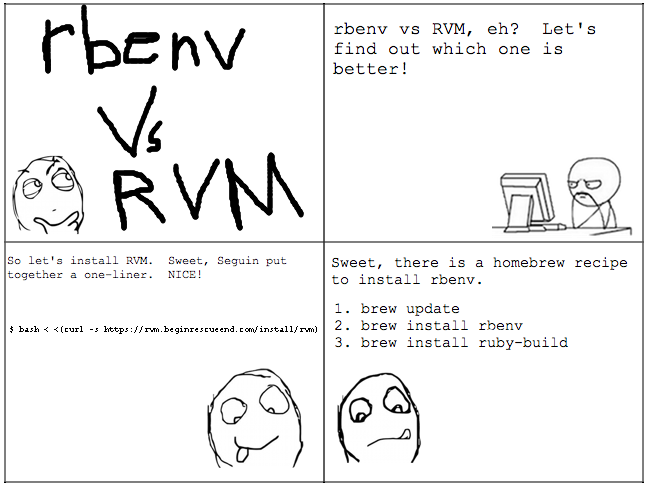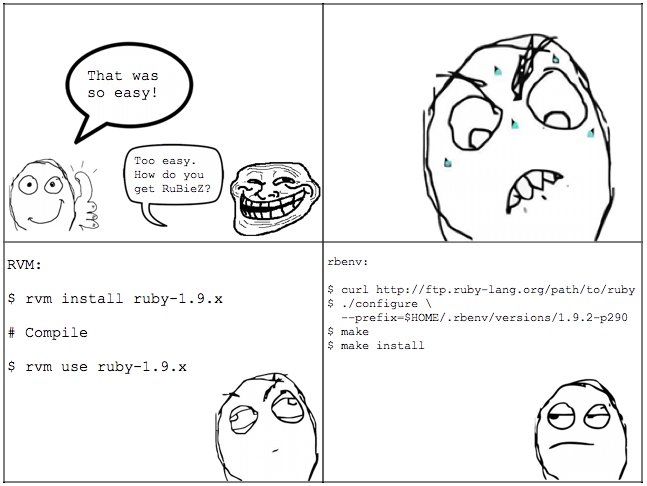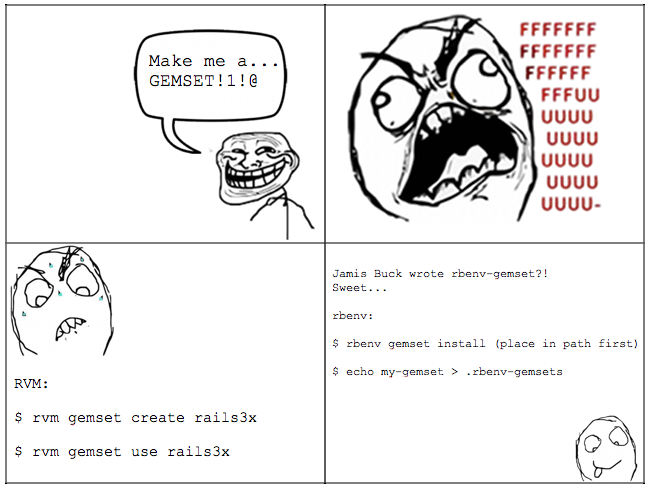RVM and rbenv
Many of you are familiar with rbenv and some of the controversy surrounding it. I love RVM and will more than likely continue to use it, but one of the things I truly value in the ruby community is always having more than one option. I was delightfully surprised with the simplicity of rbenv, how easy it was, and how familiar it felt right out of the box. This article will provide a (humorous) side-by-side comparison of the basic usage and installation of rbenv and RVM.
Installation

In RVM you need to add this to your profile to load the RVM function.
# or ~/.zshrc
$ echo '[[ -s "$HOME/.rvm/scripts/rvm" ]] && . "$HOME/.rvm/scripts/rvm" # Load RVM function' >> ~/.bash_profile
In rbenv you need to add this to your profile to load the rbenv command-line function.
# or ~/.zshrc
$ echo 'export PATH="$HOME/.rbenv/bin:$PATH"' >> ~/.bash_profile
$ echo 'eval "$(rbenv init -)"' >> ~/.bash_profile #to enable shims and auto-complete
Once you've restarted your shell you now have access to RVM/rbenv. It is important to note that RVM and rbenv cannot be installed at the same time because of the way RVM handles the 'gem' command.
Get Rubies

In RVM you install your rubies to /Users/$USER/.rvm/rubies/ruby-1.9.2-x in rbenv your rubies are installed to ~/.rbenv/versions. Sam Stephenson created a sister gem for rbenv called ruby-build which offers several convencience methods for installing/compiling your own rubies.
For instance, once you have ruby-build installed you can type this:
$ rbenv install ruby-1.9.2-x
So now you have your rubies. Best blog post EVAR! Wait, there's more...
Gemsets

Gemsets are my favorite thing about RVM and I was happy to see rbenv has that functionality easily available [1].
But wait, what about cd and gem?
RVM overrides cd and gem commands to enable some of its functionality. "What about those commands?" you ask. To which I reply: if that is an issue then rbenv might be a better fit. However, I doubt the majority of users will ever have a problem with the over-ride of these commands.

Conclusions
You saw the strips above, they offer a lot of the same functionality. In many ways rbenv and RVM are really just two sides of the same coin. A different way to solve the same problem. I will say this article is from a purely functional stance, I understand that under the hood rbenv and RVM are quite different.
There has been quite a bit of controversy surrounding the rbenv/rvm divide. I think, after installing both back-to-back on my own system, that their similarities outweigh their differences. One article I read about the subject compared RVM and rbenv to Rails and Sinatra [2]. I think that comparison really fits. Sinatra is a lightweight framework whereas Rails is much more robust. Sometimes sinatra just fits, and other times you'd be a fool to not go with Rails. If you need the features in RVM then use it, if you want more control and a lighter feel then use rbenv. It's all a matter of preference.
As a rubyist I'm just glad we have people like Wayne Seguin, and Sam Stephenson contributing to the community the way they do.
References
1.) rbenv gemset
2.) Ruby Inside - rbenv article
Additional References (Reading)
Begin Rescue End (RVM home page)
rbenv on github
Rage-Builder


